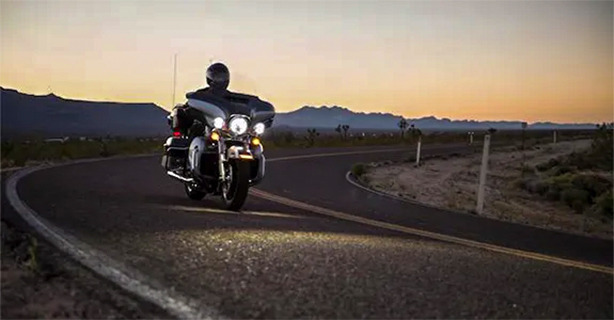MOTORCYCLE SAFETY TIPS DURING DEER SEASON
There are so many events that motorcycle riders can prepare for.
We can hone our reaction times to dangerous situations by practicing parking lot drills or auditing advanced safety classes from the Motorcycle Safety Foundation.
We can work on our reflexes and concentration by riding on track days and always remember to wear all of our protective gear all the time (ATGATT).
As the summer winds down, the beautiful falling leaves start to hit the ground in the cooler autumn months, and the sun sets just a little bit earlier every day.
But regular riders are still out in the dusky light, and unfortunately for those riders, it's also the season for deer to be most active.
WHAT TO KNOW ABOUT DEER SEASON
The deer season coincides with the spring and summer riding seasons.
As the weather gets more moderate, the deer begin to become more active while looking for mates.
At certain times of day (dawn and dusk), deer are especially active and cross through different territories looking for love.
They don't care if they are on a country road or the interstate; deer will cross a busy traffic lane regardless of oncoming traffic whenever they feel like it.
Deer often travel the same paths, which (luckily for us) are known to hunters and wildlife services. These deer crossings are often marked with special deer crossing signs, which need to be constantly scanned for.
Herds of deer often stay together, so when one is present, be extra cautious.
Deer season is one of the few events that throw even the most safety-focused and prepared riders. AAA reports that motorcycles account for 70% of deer-related incidents.
SAFETY TIPS FOR DEER SEASON
Now that the deer population is estimated at around 30 million and growing, it's as important for every novice who just got their motorcycle license as it is for an experienced rider to know what riding in deer country means.
Dealing with wildlife removes rational factors from the situation. When they cross the road, they don't check for motorcycles or cars driving in the oncoming lanes.
That's why it's up to motorists to stay vigilant and stay safe.
1. Train For The Unexpected
If you plan on riding through the fall and spring deer season, you must have a few advanced motorcycle tools in your proverbial riding belt.
Advanced road training is offered at specialty motorcycle schools across the country and can give you practical skill sets beyond what is offered in the traffic safety program run by the MSF. But safe riding practices are not grown in a vacuum.
Reacting to different stimuli while on the motorcycle will help smooth riding when a real problem arrives.
For new riders, the MSF course is an incredible way to train yourself for what the road can throw at you.
2. Ride At The Right Time Of Day
Dusk and dawn are often the most dangerous times of day to be riding your motorcycle, and not only during deer season.
Alcohol impairment and dark roads can lead to adverse conditions for motorcyclists. Combine these with bad weather or wet leaves, and you have highly dangerous low-light conditions that will limit your ability to see danger coming.
If possible, avoid night riding and stick to riding during daylight hours; if not, stick to well-illuminated roads whenever possible.
3. All The Gear All The Time
Safety gear gets a bad rep in some motorcycling communities. One of the major factors in motorcycle fatalities is how much protective gear the rider wore.
At the very minimum, a DOT-compliant motorcycle helmet is needed. But we recommend going much further with boots that provide ankle protection, clothing made for the crash with Kevlar and armor, gloves that can protect your hands, and anything else that allows you to stay safe in the event of an unexpected impact.
4. Practice Makes Permanent
Before you get on the road, you should make a mental list of what needs to be checked on your bike.
Are your brakes in working order?
How about the cables and turn signals?
Is everything firing up correctly?
Once you're on the bike, you're scanning for cars while thinking about work, and you're looking left to right when suddenly there's a deer in your path.
Your front brake could save your life in this situation, but do you know how to use it in an emergency stop?
Did you squeeze the brake lever instead of grabbing while slowly applying pressure to the foot brake and using the foot pegs for balance?
There are so many things to think about on every motorcycle trip, and without practice, you may not have the skills you need to stay safe.
So if you need to address some blind spots in your skill set, consider a more advanced motorcycle rider education course with one-on-one instruction.
5. Consider The Road
Are you riding on a public road or a private road?
Is it well maintained or illuminated?
Are you sharing the road with motorcyclists or just passenger vehicles?
Every road should be assessed as you ride. Note the traffic flow ahead of you, and pay attention to roadkill, frost, ice, or animal activity.
Constant vigilance!
WHAT NOT TO DO
Do not speed up; this is an incorrect way to deal with deer.
Do not grab the brake, gently squeeze.
Do not rely on deer whistles; in the last decade, these have been almost entirely discredited as ineffective.
Do not ride an unfamiliar motorcycle in adverse conditions.
Do not be distracted by the beautiful leaves.
STAY SAFE
Ultimately every rider is in their own hands, but with common sense and practice, you can significantly improve your odds of avoiding a deer collision.
Stay safe out there, and stay vigilant!

